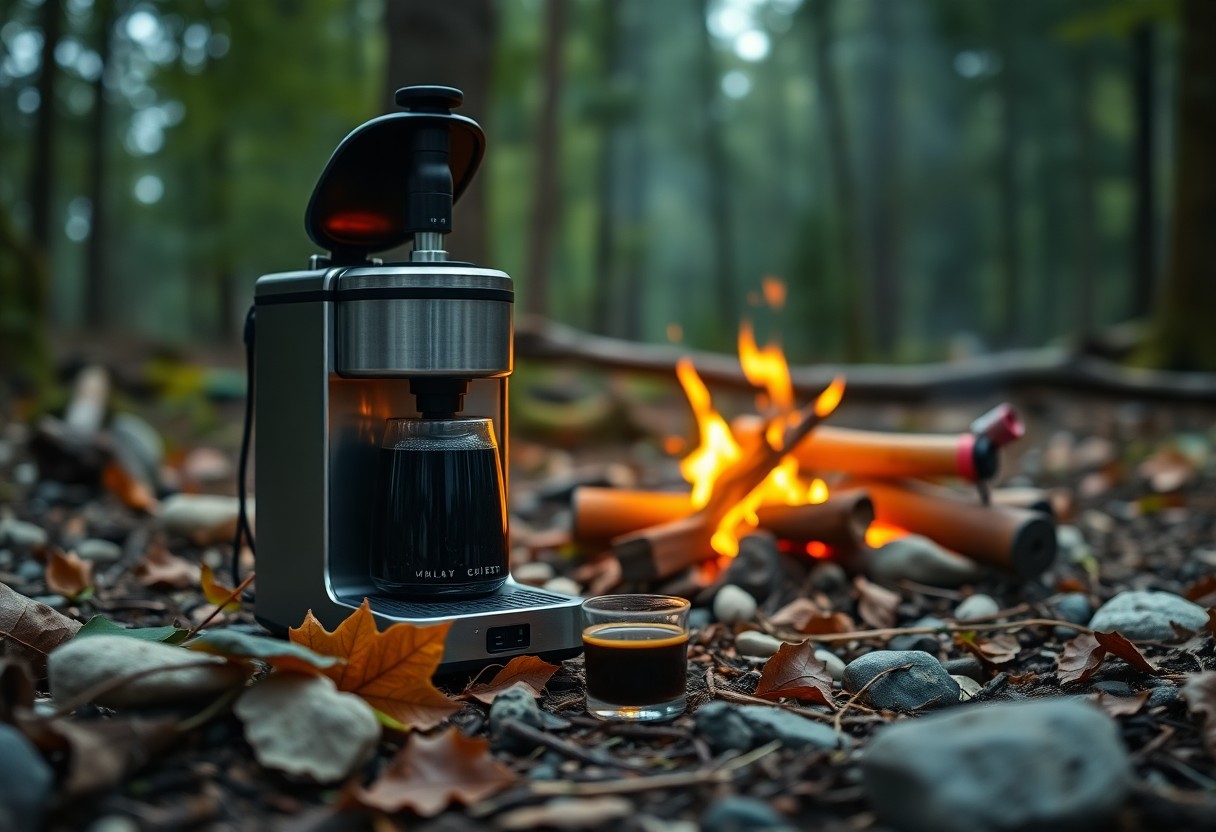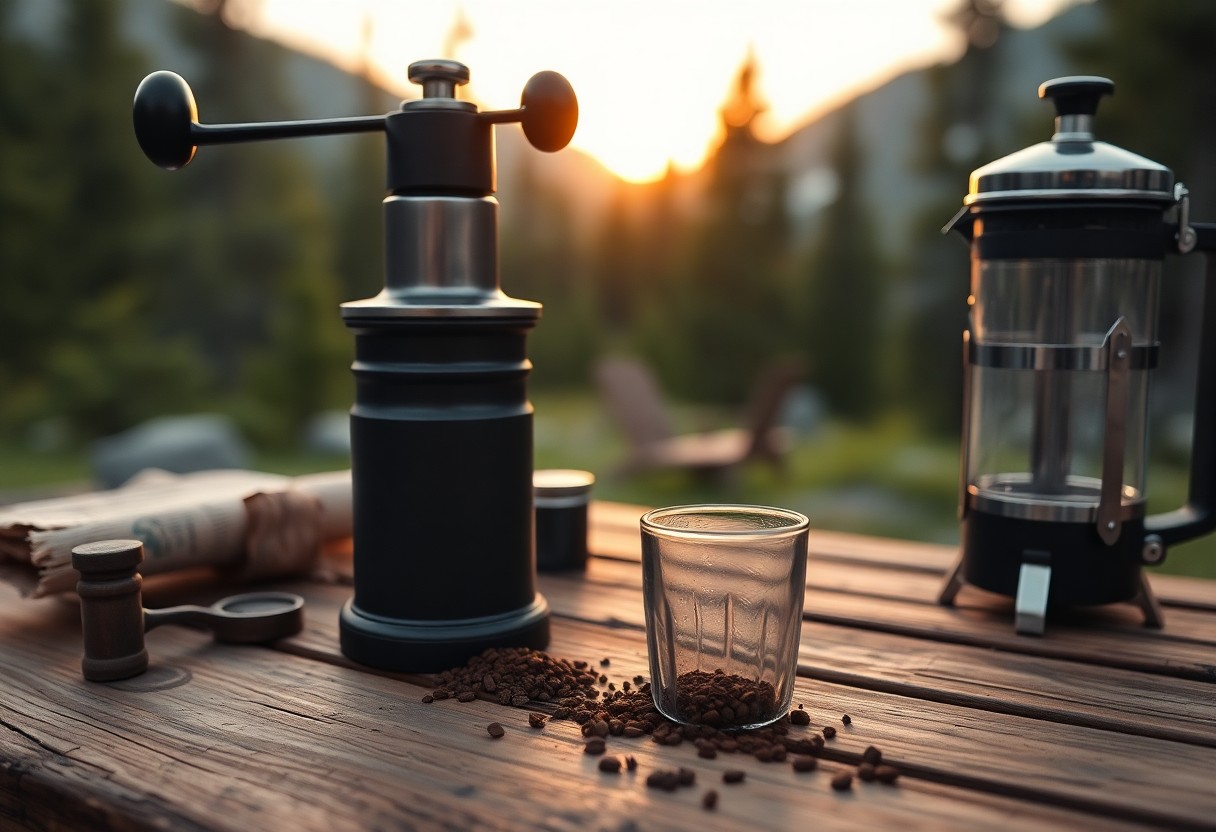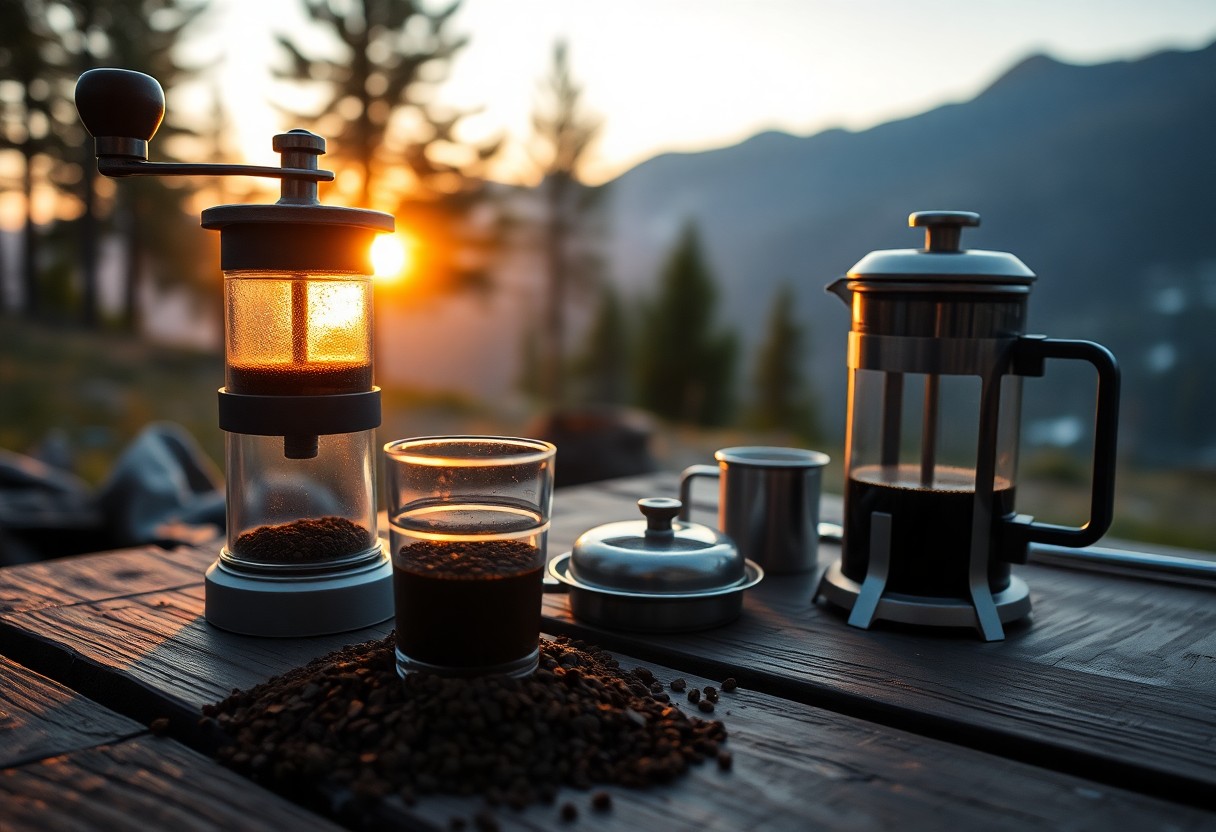Manual brewing allows you to savor the rich flavors of espresso in remote locations, free from the confines of electricity. This guide will equip you with the skills to create a perfect shot using only your passion and minimal equipment. By employing techniques like using a camp stove or a portable espresso maker, you can achieve a delightful brew that will energize your outdoor adventures. Stay safe by ensuring proper handling of boiling water and equipment, and embrace the joy of crafting espresso under the open sky!
Key Takeaways:
- Learn various manual brewing methods that allow you to extract espresso flavor without relying on electrical appliances.
- Understand the importance of water temperature and pressure, and how to achieve optimal conditions using alternative tools.
- Explore different beans and grind sizes that complement outdoor brewing, enhancing the overall flavor of your espresso experience.

Crafting the Perfect Brew: Choosing Your Equipment
To pull a great espresso shot off the grid, the selection of your equipment plays a vital role. Concentrating on gear that supports manual brewing is key, allowing you to maintain control over your extraction process. The right tools not only enhance the experience but also ensure that every shot you pull is packed with flavor, aroma, and intensity, even without the convenience of electricity.
Essential Gear for Manual Espresso Making
Your necessary gear should include a high-quality manual espresso maker, a reliable grinder, and the right accessories like a tamp and scale. A hand-powered espresso machine, such as the Flair Espresso Maker or the AeroPress, can provide an authentic espresso experience by relying on your strength and technique. Investing in a conical burr grinder will allow for a consistent grind size, which is vital for achieving optimal extraction.
The Benefits of Portable Espresso Machines
Portable espresso machines offer unmatched convenience for coffee lovers on the go. You can easily pack them into your camping gear or carry them on a hike, ensuring your caffeine fix is within reach no matter where you are. Lightweight and compact, these devices can still deliver rich, full-bodied shots that rival those made at home or in your favorite café.
With a range of designs available, portable espresso machines often come with built-in features, such as pressure gauges and brewing timers, allowing you to hone your technique while experiencing new locations. Many models require no electricity, can utilize various brewing techniques, and accept coffee grounds, capsules, or pods. This adaptability means you can enjoy espresso tailored to your taste preferences wherever you roam, transforming wild adventures into a café experience under the stars.
Mastering Temperature Control: Harnessing Nature’s Elements
Maintaining the ideal water temperature is imperative for extracting the perfect espresso shot, especially when relying on natural elements. By understanding how to control temperature using available resources, you can create a satisfying brew even in the wild. Below are key strategies to help you manage heat effectively.
| Method | Description |
|---|---|
| Solar Heating | Utilizing direct sunlight to warm water via dark containers. |
| Wind Shields | Implementing barriers to trap heat from the sun or fire. |
| Insulation Materials | Using natural fibers or soil to retain heat. |
| Water Temperature Monitoring | Employing thermometers or simple touch tests to gauge heat. |
Techniques for Achieving Optimal Water Temperature
The right techniques can make all the difference when it comes to reaching the optimal water temperature for espresso. Start by using shallow vessels to increase the surface area, and consider adding a few heated stones to the water. Monitoring the temperature regularly ensures you stay within the 195°F to 205°F range, yielding a balanced extraction without over or under-extraction issues.
| Technique | Description |
|---|---|
| Shallow Vessels | Enhances heat absorption and reduces boiling time. |
| Heated Stones | Maintains stable warmth when placed in the water. |
Utilizing Fire or Alternative Heat Sources Safely
Sourcing heat from fire or alternate methods necessitates a focus on safety. Construct a safe fire pit away from flammable materials, and ensure that you have good ventilation to avoid smoke inhalation. Use sturdy, heat-resistant containers for your water to prevent accidents when heat intensifies. By layering stones around a fire setup, you can create a natural heat sink that helps regulate temperature effectively, ensuring that the exposed surfaces don’t reach dangerously high temperatures.
When utilizing fire or other heat sources, always prioritize safety measures. Opt for a controlled fire setup—dig a pit or surround your flame with stones. Keep a bucket of water or sand nearby to extinguish any unwanted flames quickly. Consider using a pot with sturdy handles that can withstand high heat while allowing you to pour your water safely. Pay attention to wind direction to manage potential sparks, and never leave your fire unattended. This way, you can enjoy the rustic experience of brewing espresso in the wild without compromising on safety.

The Art of Grinding: Achieving the Right Consistency
Grinding your coffee beans to the right consistency sets the foundation for an exceptional espresso experience. The grind size has a profound impact on extraction; too coarse will yield weak flavors while too fine can lead to over-extraction and bitterness. In the wild, a consistent grind produced by an appropriate grinder is your secret weapon for creating that rich, velvety espresso. Mastering this art can elevate your brewing game, providing an energy-boosting delight even far from home.
Selecting the Right Grinder for Your Adventure
Your choice of grinder significantly influences the quality of your espresso. Opt for a lightweight, portable hand grinder designed for travel. A burr grinder offers a consistent grind, which is crucial for even extraction. Manual options are particularly suitable in off-grid situations, as they require no electricity. Look for one with a fine range setting, allowing you to adapt the grind size based on your brewing method and external conditions.
How Grind Size Affects Extraction and Flavor
A well-chosen grind size perfectly balances extraction and flavor. Finer grinds allow water to extract flavors quickly, while coarser grinds slow down extraction. The ideal grind varies based on your chosen method and equipment, but generally, espresso requires a fine grind for optimal results. Finding that sweet spot ensures you can avoid the pitfall of bitter or sour shots, leading to a fuller body and more nuanced flavor profile in your brew.
For instance, a finer grind increases the surface area exposed to water, extracting oils and flavors more efficiently. This leads to a richer crema and a more concentrated taste. A typical espresso will benefit from a grind size between 18 to 24 microns; however, your specific equipment might require slight adjustments. If the grind is too fine, the extraction can become too intense, yielding a harsher taste. Conversely, using too coarse a grind will result in under-extraction, giving a weak and sour flavor. Therefore, achieving the right consistency becomes pivotal in crafting that balanced, invigorating shot when you’re out in nature.
Pressure Techniques: Mimicking Espresso Machines
Creating the right pressure is vital for extracting that rich, flavorful shot of espresso. Without the luxury of an electric machine, you can still achieve similar results by utilizing alternative methods. Understanding how to generate and maintain pressure effectively is key to ensuring your coffee grounds release their full flavor potential. Mastering these techniques turns your outdoor coffee experience into a delightful adventure.
Manual Techniques to Generate Pressure
Employing manual techniques can provide an impressive way to generate the necessary pressure for espresso. Lever systems, such as a lever espresso machine or a simple hand-pump device, rely on the physical force you apply to push water through the coffee grounds. Pressure should ideally reach around 9 bars to properly extract your espresso, and with the right tool, you can accomplish this effectively using your own strength.
Exploring Leverage: Relying on Your Body Mechanics
Leverage is a powerful ally in your quest for a perfect espresso shot. By using your body mechanics to your advantage, you can apply consistent pressure without exhausting yourself. Think about how a weightlifter employs their legs and core to lift weight rather than just their arms. Similarly, by incorporating your entire body—bending at the knees and using your core to create a strong base—you can generate the necessary force to push through the coffee grounds efficiently. This technique helps you maintain stability and control, resulting in a smoother extraction process.
Perfecting the Extraction: Timing and Technique
Your timing and technique play pivotal roles in achieving the perfect extraction. Aim for a brew time of about 25-30 seconds; this is where the magic happens. A watchful eye on the flow of the coffee will help you gauge the process. The ideal shot will have a steady stream resembling warm, honey-like syrup, showcasing a rich crema on top. Master this delicate dance of time and pressure, and you’ll elevate your coffee experience to new heights.
Signs of a Well-Pulled Shot
Troubleshooting Common Extraction Issues
Extraction issues can rob your espresso of quality, but identifying the signs can guide you back on track. If your shot is too bitter, it could mean an over-extraction due to improper grind size or prolonged brewing time. A sour taste often indicates under-extraction, caused by insufficient pressure or too coarse a grind. Adjust your variables accordingly to balance the flavors for a harmonious brew.
Summing up
Taking this into account, pulling a shot of espresso without electricity can be a rewarding adventure that enhances your appreciation for the brewing process. By utilizing methods like a stovetop espresso maker or a portable espresso machine, you can enjoy rich and flavorful shots no matter where you are. Embrace your resourcefulness and experiment with different techniques to find what works best for you, ensuring a smooth and enjoyable espresso journey in the wild.
FAQ
Q: What are the best methods for brewing espresso without electricity?
A: There are several methods to brew espresso without electricity, including using a stovetop espresso maker, a French press, or a vacuum coffee maker. The stovetop espresso maker, often called a Moka pot, is especially popular for creating rich, concentrated coffee similar to traditional espresso. Just heat water on a camping stove or an open fire, and you can brew a satisfying shot of espresso without needing electrical power.
Q: What equipment do I need to pull a shot of espresso in the wild?
A: Key equipment includes a portable espresso maker (like a manual espresso press), a grinder for your coffee beans, and a source of heat such as a camping stove or open flame. Additionally, a thermometer or temperature indicator can help ensure that the water is at the right temperature (around 190-200°F) for the best extraction.
Q: How do I properly grind coffee beans for my espresso without electricity?
A: To grind coffee beans without electricity, you can use a manual hand grinder or a mortar and pestle. Aim for a fine grind, similar to table salt, for optimal extraction. If using a mortar and pestle, take care to grind the beans evenly to achieve the best flavor profile. Hand grinders typically have adjustable settings, allowing you to refine your grind to suit your taste.
Q: What is the ideal coffee-to-water ratio for brewing espresso in the wild?
A: A common coffee-to-water ratio for espresso is about 1:2, meaning for every 1 gram of coffee, you would use 2 grams of water. For a standard single shot (about 30ml), this usually translates to around 7-9 grams of coffee. Adjust this ratio based on personal preference, as some may prefer a stronger or milder shot.
Q: How do I maintain the ideal brewing temperature when making espresso outdoors?
A: To maintain the ideal brewing temperature, heat your water to the target range and remove it from the heat source just before it reaches a boil to prevent temperature fluctuations. If you’re using a Moka pot, pay attention to the heat level to avoid scorching the coffee. Alternatively, you can preheat your water in a thermos to keep it hot while you prepare your espresso equipment.
